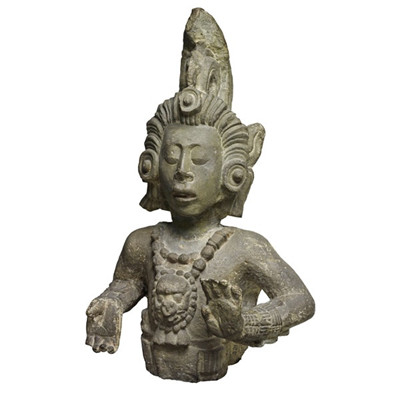(单词翻译:单击)
中英文本
Across the world, people began to identify particular plants that would provide them with food. In the Middle East-as we saw in the last programme-it was wheat and barley; in China millet and rice; in Papua New Guinea taro; and in Africa sorghum. And, as they did so, everywhere stories about gods emerged; gods of death and of rebirth, gods who would guarantee the cycle of the seasons and ensure the return of the crops, and gods-more importantly-that represent food itself. Today's object is myth-made material; a food god from Central America.
在世界各地,人类开始学会识别特定的植物,当成提供食物的农作物。在中东,我们在上期节目中已经看到的,出现的是小麦和大麦;在中国,小米和大米;在巴布亚新几内亚是芋头;在非洲是高粱。随着这些作物的降临,涌现出各种各样的神灵与相关他们的故事,死神、重生之神、掌管季节变换之神、保佐丰收之神,以及最最重要的,代表食物本身的神灵。今天要介绍的物品就是充满了神话色彩,一位来自中美洲的食物之神。
Here, in the heart of the British Museum, we have a god of maize. He's a bust, carved of limestone using a stone chisel and a basalt hammer, and the features are large, symmetrical, the eyes closed, the lips parted-as though this god is in communion with a different world, quietly meditating.
在大英博物馆的中央,我们有一尊玉米之神。他是一件胸像,使用石凿和玄武岩锤在一块石灰石上雕刻出来的。五官宏大,左右对称,双眼紧闭,嘴唇分开,仿佛这位神灵正在与另一个世界进行沟通,沉浸在冥想中。
The arms are bent, the palms of the hands face outwards-one raised, one lower-giving an impression of serene power. The head of the god is covered with an enormous headdress in the shape of a stylised corn cob, and his hair is like the silky strands that line the inside of a cob of corn, inside the wrapping leaves.
双臂弯曲,双掌手头向上,一只抬高,一只较低;让人感觉到一股安祥而强大的力量。神像头部覆盖着一个巨大的头饰,具有很强装饰色彩的玉米芯形状,他的头发就像是玉米须,丝绸般的,跟玉米芯一起被包裹在重重叠叠的玉米叶里。
Originally this statue would have sat with many other similar gods high up on a stepped pyramid-style temple in western Honduras. He was found in Copan, a major Mayan city and religious centre, whose monumental ruins you can still visit today. All of the temple's statues were commissioned by the Mayan ruler of the day, to adorn the magnificent temple that he built at Copan around AD 700. Between the head and the body you can very clearly see the join, and indeed the head looks rather too big for the body, because when the temple in Copan was destroyed, all the statues fell, and heads and bodies were pieced together, but whether this head and this body precisely belong together is actually not the key thing-because all these gods are about the central power, the central role, of maize to the local people.
本来这尊石像应该与许多其他类似的神像一起,被供奉在洪都拉斯西部那高高的玛雅阶梯式金字塔上的寺庙里。他出土于科潘,一个重要的玛雅城市与宗教中心;直到今天你仍然可以去探访宏伟壮观的遗址。当年玛雅王下命雕刻了这里所有的神像,来装饰这座大概公元700左右建造于科潘的雄伟庙宇。仔细观察一下这件胸像,你可以看出颈部那边有一条明显的拼接线,而且这头像放当在身体上颇显头重脚轻之感。其实这是因为当年出土这神像的科潘神庙曾经被摧毁过,所有的神像都倒蹋了。后来人类重新把散落一地的各个头像与身躯给拼凑起来,所以我们眼前这尊神像就拼成这样子了。不过这头与身是不是原本是一体,这倒是其次,重点是所有这位神灵都代表着玛雅文化中的中央集权、核心作用,也就是当地人民的命脉—玉米。
Our statue of the maize god is obviously a comparative new boy; he's made as late as AD 700. But he comes at the end of a very long tradition; Central Americans had been worshipping him and his predecessors for thousands of years, and his mythic story mirrors the annual planting and harvesting of the corn on which all Central American civilisation depended.
我们这奠神像相对而言可谓是个比较晚辈的小弟弟了,大概制造于公元700年左右。不过他传承了一段相当长的传统;在过去几千年的岁月里,中美洲的人们一直在祭拜他与他的各位前任,而且有关他的神话故事栩栩如生地描绘了所有中美洲文明从古以来依赖的玉米种植与收成,年年如此,生生不息。
Like the maize plant, the maize god is decapitated at harvest time, and is then reborn-fresh, young, and beautiful at the beginning of each new growing season. John Staller, anthropologist and author of the book Histories of Maize explains why the maize god was a common choice for rich and powerful patrons.
就像玉米植株一样,收割季节时,玉米神的头颅就会被割下来,然后再重生,在每一轮新的生长季节都将青春焕发、活力充沛、健美茁壮。人类学家约翰?斯托勒著作了《玉米的历史》这本书,他向我们解释了为什么玉米神公认为富饶与权力的守护神。

重点讲解
1.begin to 开始
Within minutes brain cells begin to die.
几分钟后脑细胞开始死亡。
Nobody wants to watch your science projects blossom mold or begin to stink up the communal space.
没有人想看着你的科研项目绽放“霉菌”,也没人想看到它们把整个公共空间搞得臭气熏天。
2.cover with 用…遮盖住,用…填满
Cover with a primer; apply a primer to.
用底漆覆盖;给……涂抹底漆。
Estimation of winter wheat residue cover with hj-1b data.
基于hj-1b数据的冬小麦留茬覆盖度遥感估算。
3.choice for 选择
No, collaboration seems to be the word of choice for management experts and informed ceos alike. "
管理专家和明智的首席执行官都会选择协作,而非竞争。
This is ultimately a choice for the member states.
这是欧盟成员国排在最后的选择。


